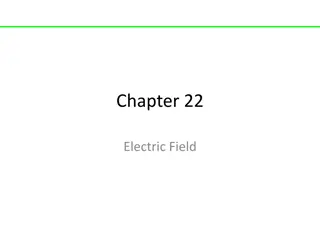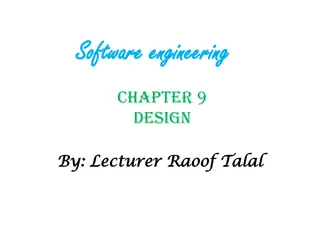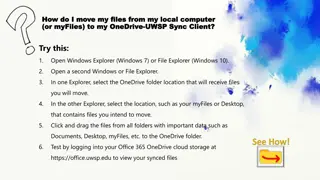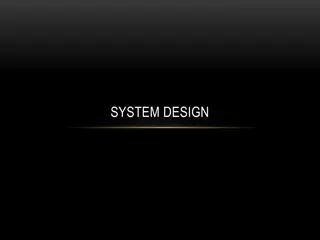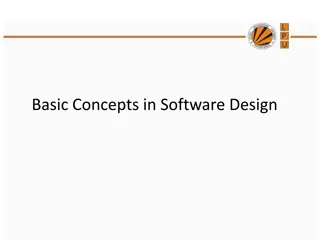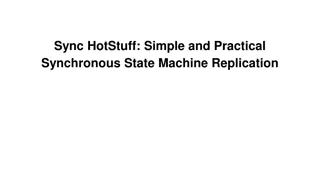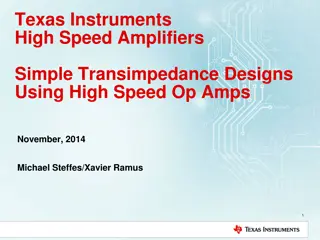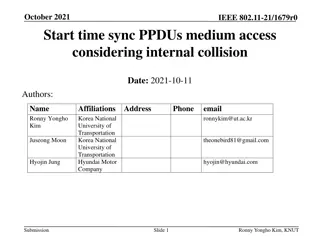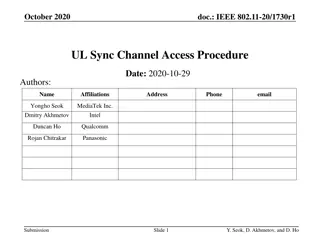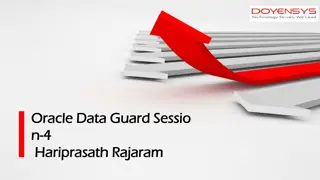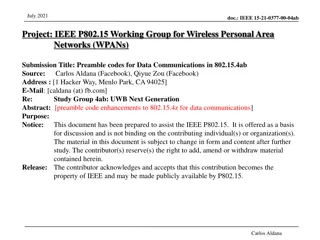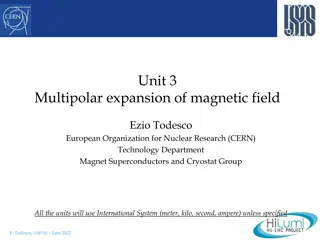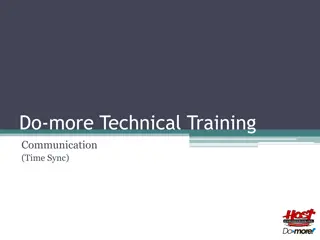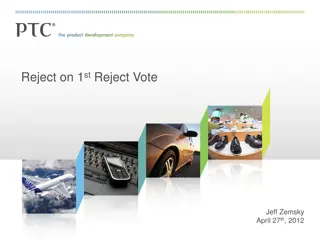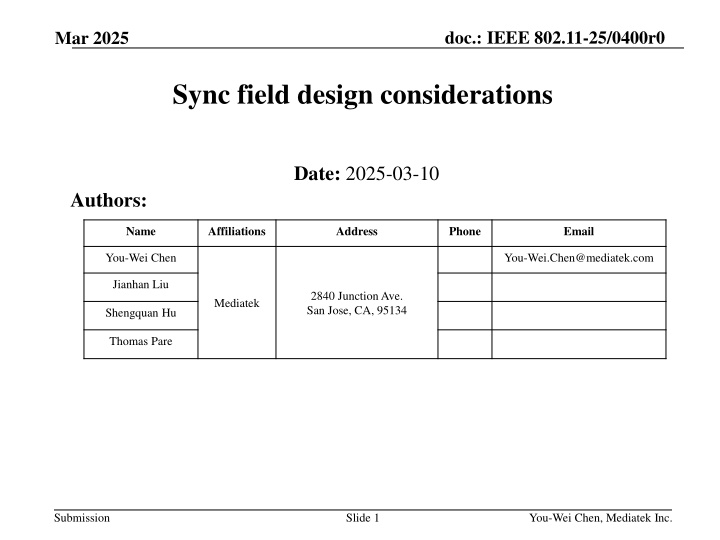
IEEE 802.11-25/0400r0 Sync Field Design Considerations Mar 2025
Explore the design considerations for sync fields in IEEE 802.11-25/0400r0, focusing on backscatter and non-backscatter communication for AMP STAs. The presentation covers passed motions, AMP PPDU formats, sync sequences, chip durations, and design implications for different data rates and STA types.
Download Presentation

Please find below an Image/Link to download the presentation.
The content on the website is provided AS IS for your information and personal use only. It may not be sold, licensed, or shared on other websites without obtaining consent from the author. If you encounter any issues during the download, it is possible that the publisher has removed the file from their server.
You are allowed to download the files provided on this website for personal or commercial use, subject to the condition that they are used lawfully. All files are the property of their respective owners.
The content on the website is provided AS IS for your information and personal use only. It may not be sold, licensed, or shared on other websites without obtaining consent from the author.
E N D
Presentation Transcript
doc.: IEEE 802.11-25/0400r0 Mar 2025 Sync field design considerations Date: 2025-03-10 Authors: Name Affiliations Address Phone Email You-Wei Chen You-Wei.Chen@mediatek.com Jianhan Liu 2840 Junction Ave. San Jose, CA, 95134 Mediatek Shengquan Hu Thomas Pare Submission Slide 1 You-Wei Chen, Mediatek Inc.
doc.: IEEE 802.11-25/0400r0 Mar 2025 Introduction Sync field design for backscatter and non-backscatter non-AP AMP STAs are widely discussed [1-6]. Passed motion [7]: IEEE 802.11bp defines at least one AMP-Sync in the AMP Downlink PPDU in 2.4 GHz for backscatter communication, and at least one AMP-Sync in the AMP Downlink PPDU in 2.4 GHz for non-backscatter communication. The AMP-Sync is independent of the integrated and non-integrated deployment. In this presentation, we will review some contributions related to sync design and discuss out thought. Submission Slide 2 You-Wei Chen, Mediatek Inc.
doc.: IEEE 802.11-25/0400r0 Mar 2025 Passed: AMP PPDU formats Since receiver capabilities for backscatter and non-backscatter non-AP STAs are quite different, DL sync designs can be different. Currently, chip duration of 2us is only for backscatter type DL PPDU. Submission Slide 3 You-Wei Chen, Mediatek Inc.
doc.: IEEE 802.11-25/0400r0 Mar 2025 Brief summary of contributions length chip duration (us) 25/27r1 25/34r2 DL sync1 for 250kbps 32 S1=[?2 ?2] 2 (or 1?) Different sync sequences for DL/UL for indication. The sequence have 3 consecutive 1/0, to help distinguish synchronization field and data field with Manchester coding. For AMP sync field, the performance will be affected by: Length of sync filed, Chip duration, Sampling rate of AMP STA s receiver. DL sync2 for 1Mbps 16 S2=[1100100101011100] 2 (or 0.5/1?) 25/27r1 UL syncs are same for all Uniform sync design for backscattering and active Tx Chip duration scale with data rate. 25/42r0 DL sync for 1Mbps 32 S1=[10100100101110110001011100111000] 0.5 Check X-corr, CLK accuracy, X-corr w/ backscattering, Possible implementations. 25/47r0 DL sync1 for 250kbps 32 S1=[?2 ?2] 2 Unified Sync field for both integrated and non-integrated deployments DL sync2 for 1Mbps 16 S2=[0101011011000011] 2 DL for backscattering 8 S3=[10110001] 2 25/48r0 UL for backscattering S4=[111010] Includes invalid Manchester pattern (e.g., 3 continuous 1s or 0s) to signal the start of synchronization Ends with a valid Manchester pattern, marking the beginning of valid data 25/75r2 DL for backscattering 8 S1=[01111101] 2 The first OFF PW indicate the start of DL modulation 5 PW ON carrier is a code violation (non-Manchester). This duration also differentiates from data-0 signal of any Tari/PW in EPC Gen2. The last 0/1 transition provides timing for Data Manchester decoding Submission Slide 4 You-Wei Chen, Mediatek Inc.
doc.: IEEE 802.11-25/0400r0 Mar 2025 Few checkboxes for Sync field design Each Sync field need to have a low false alarm rate with different data rate and different types of non-AP AMP STAs. For example, DL S1-S3 for non-backscattering and backscattering tag. Better distinguish between Sync field, Excitation field and Data field. For example, starts with OFF, or carries consecutive 1/0. To differentiates from other standards would be an additional bonus Submission Slide 5 You-Wei Chen, Mediatek Inc.
doc.: IEEE 802.11-25/0400r0 Mar 2025 UL Sync field considerations Different DL and UL Sync field. Serve as a UL/DL indicator. Save power for third party non-AP AMP STA. Depends on the DL Sync discussion, UL Sync field should be different for backscatter and non-backscatter non-AP STAs. Since UL only be polled by AP, UL Sync for different data rate can be the same. For example, UL S1 and S2 for non-backscattering and backscattering tag, respectively. Submission Slide 6 You-Wei Chen, Mediatek Inc.
doc.: IEEE 802.11-25/0400r0 Mar 2025 Other Sync field considerations Based on aforementioned reasons, we needs: 3 DL Sync designs (2 non-backscattering +1 backscattering) 2 UL Sync designs (1 non-backscattering +1 backscattering) Sync part has a better receiver sensitivity than Data part. There should be few more steps before detailed sync field design, e.g., Data field bandwidth, receiver capabilities. Submission Slide 7 You-Wei Chen, Mediatek Inc.
doc.: IEEE 802.11-25/0400r0 Mar 2025 Straw Poll #1 Do you agree to add the following text to the SFD: DL and UL AMP-Syncs are different and can be treated as a DL/UL indicator. UL AMP-Syncs are different for non-backscatter and backscatter communication. Submission Slide 8 You-Wei Chen, Mediatek Inc.
doc.: IEEE 802.11-25/0400r0 Mar 2025 References [1] 11-25/27, AMP PPDU Design, Yinan Qi et al., OPPO [2] 11-25/34, Sync field for AMP PPDU, Wang Ke et al., OPPO [3] 11-25/42, AMP Downlink Sync Field Study, Steve Shellhammer et al., Qualcomm. [4] 11-25/47, Follow up on Downlink Sync Field Design, Bin Qian et al., Huawei. [5] 11-25/48, Discussion on Uplink Transmissions for Backscatter STAs, Bin Qian et al., Huawei [6] 11-25/75, Further Thoughts on AMP DL PPDU for Mono-static Backscattering, Rui Cao et al., NXP [7] 11-24/1322, IEEE 802.11 TGbp Motion Dock Submission Slide 9 You-Wei Chen, Mediatek Inc.


